Girard-Perregaux Tri-Axial Tourbillon reviewed by Tim Mosso
by Tim Mosso
In the modern era of luxury watchmaking, as many as four tourbillon regulators have been packed into a single watch. An alternate philosophy, albeit equally immodest, is to build fewer but better tumbling escapements. In 2014, Girard-Perregaux induced triple-takes at Baselworld with its Tri-Axial Tourbillon.
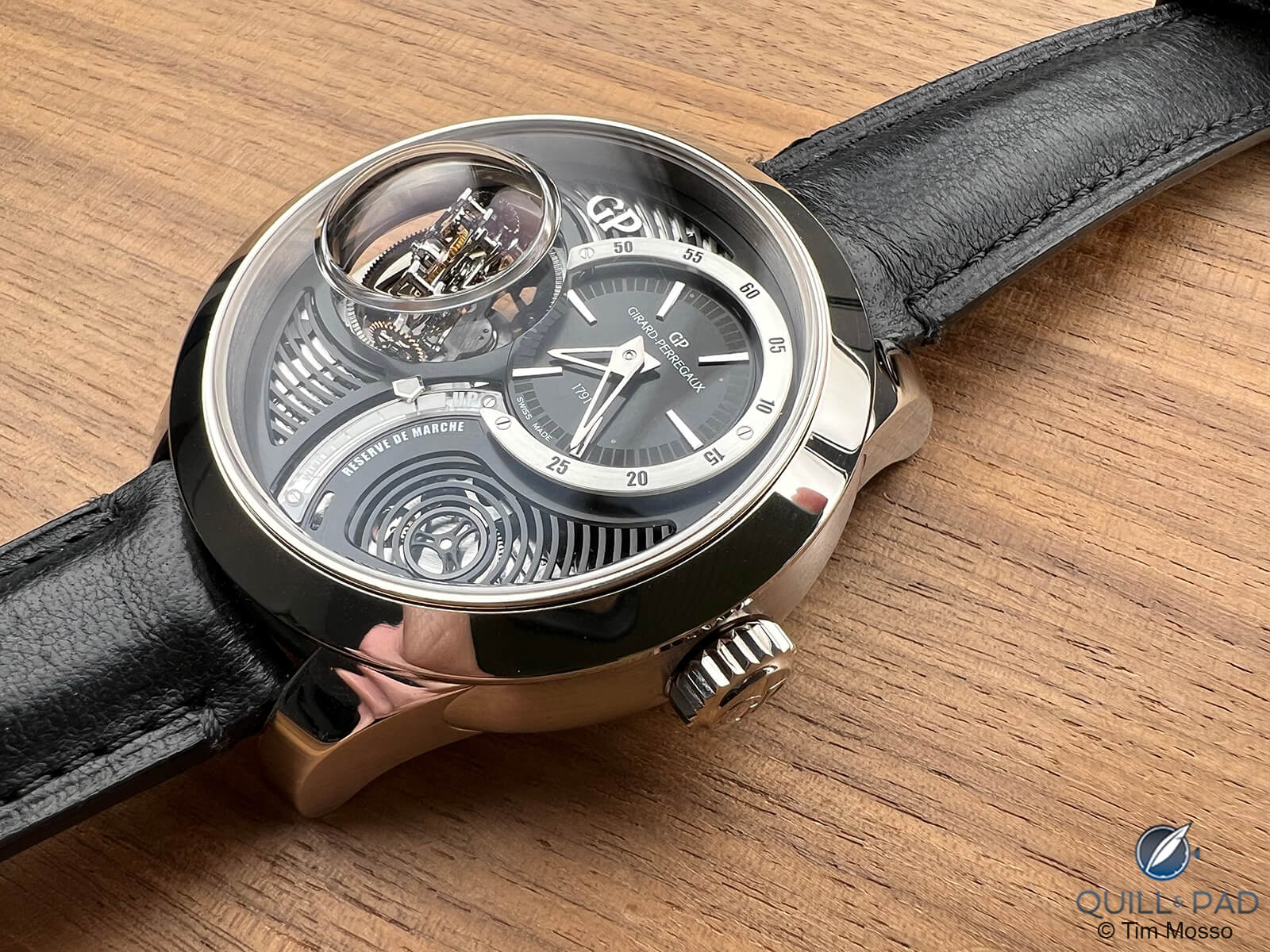
Girard-Perregaux Tri-Axial Tourbillon.
While the name is clinically literal, the romance is in the dance. And GP’s mega-watch is a thrilling dance partner.
The multi-axial tourbillon is a creature of the twenty-first century. But, as with most innovations in horology, the idea has older roots. Underrated British horologist Anthony Randall and compatriot Richard Good implemented the idea in clocks during the 1970s. Despite these origins, the idea is uniquely suited to the wristwatch era of tourbillon design; unlike a pocket watch that sits in one vertical orientation, the wristwatch rocks and rolls with the arm of its user.
In addition to coping better with the nonstandard movement of wrists, multi-axial tourbillons are at their best when perched on the nightstand or dresser in the still hours. Their ability to equalize the effects of gravity when stationary surpass even their effectiveness on the wrist.
Franck Muller’s Revolution 2 tourbillon appears to have been first with a bi-axial tourbillon in 2003. Thomas Prescher followed in 2004 with a triple-axis design. Aaron Becsei, Jaeger-LeCoultre (via Eric Coudray), and Greubel Forsey followed shortly afterward.
Others have since joined the multi-axis powers. The recent trend, exemplified by the seizure-inducing 2016 JLC Reverso Tribute Gyrotourbillon, is to achieve the fastest primary cage rotation – 12.6 seconds, in this case.
The 2014 Girard-Perregaux Tri-Axial Tourbillon resolved to ditch the rat[e] race with an inspired premise: forget speed and build the most beautiful multi-axis tourbillon. Indeed, the GP Tri-Axial shocks as much with its virtuoso detailing as by its beguiling regulator.
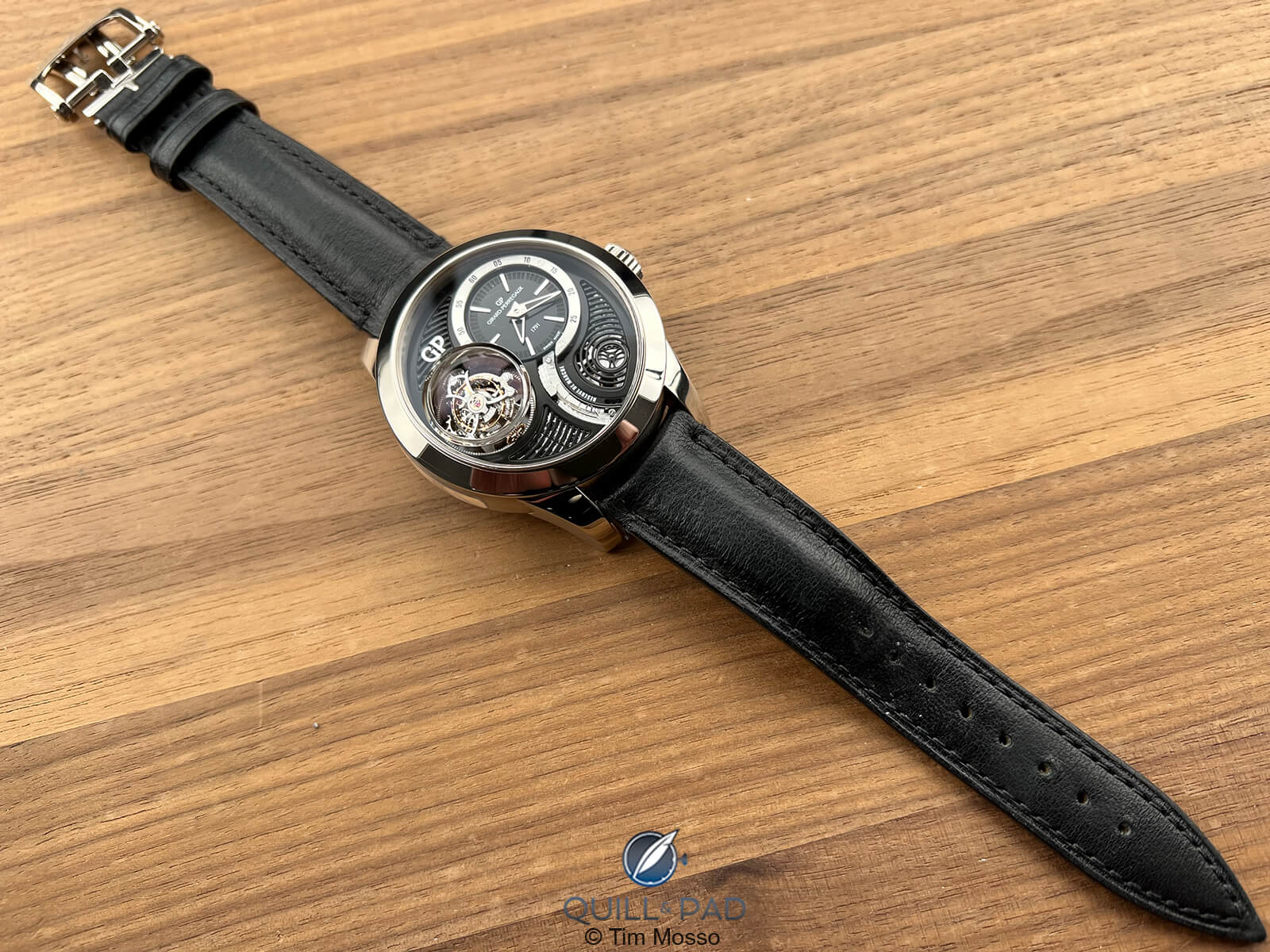
Girard-Perregaux Tri-Axial Tourbillon
The example depicted in this study is a white gold 2015 follow-up edition executed in five pieces. God is in the details, and this watch has more provocative details than Hieronymus Bosch on the warpath.
First, there’s the size. At 48mm, the GP Tri-Ax is big enough to rule out entire populations of watch collectors on ergonomics alone. But unlike most gargantuan watches of the current epoch, the Tri-Ax wasn’t inflated to match the egos of prospective customers.
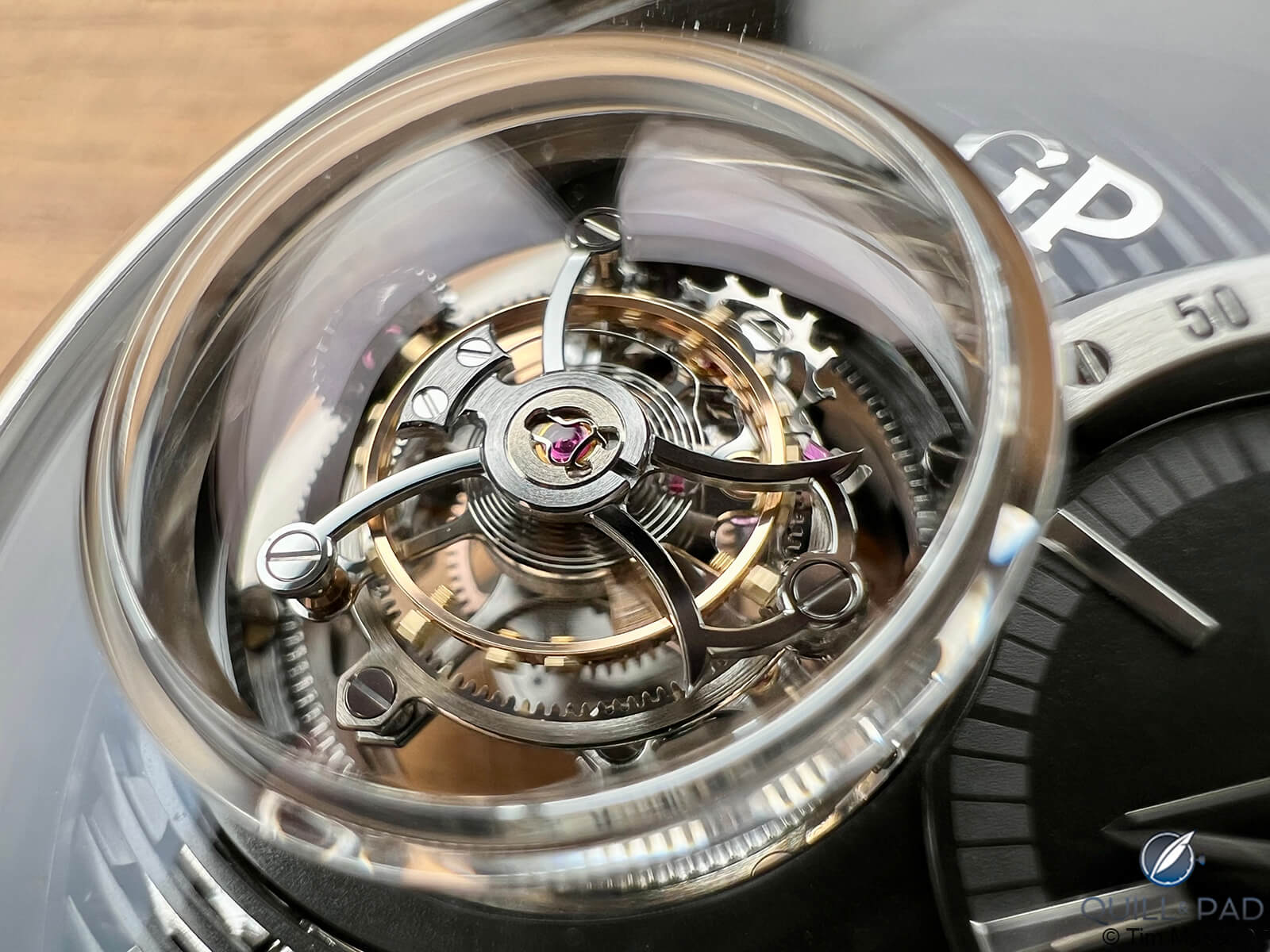
Girard-Perregaux Tri-Axial Tourbillon
The caliber GP09300-002 measures sprawling 36mm in diameter; the tourbillon cage alone spans 13.78mm. 36mm is the size of an entire Rolex Datejust, and that’s just the movement of this GP. Of course, a tourbillon requires a vast quantity of energy. A three-in-one tourbillon with a 60-hour power reserve requires colossal mainspring capacity, and the visibly huge barrel sits beneath a dedicated anthracite-colored bridge.
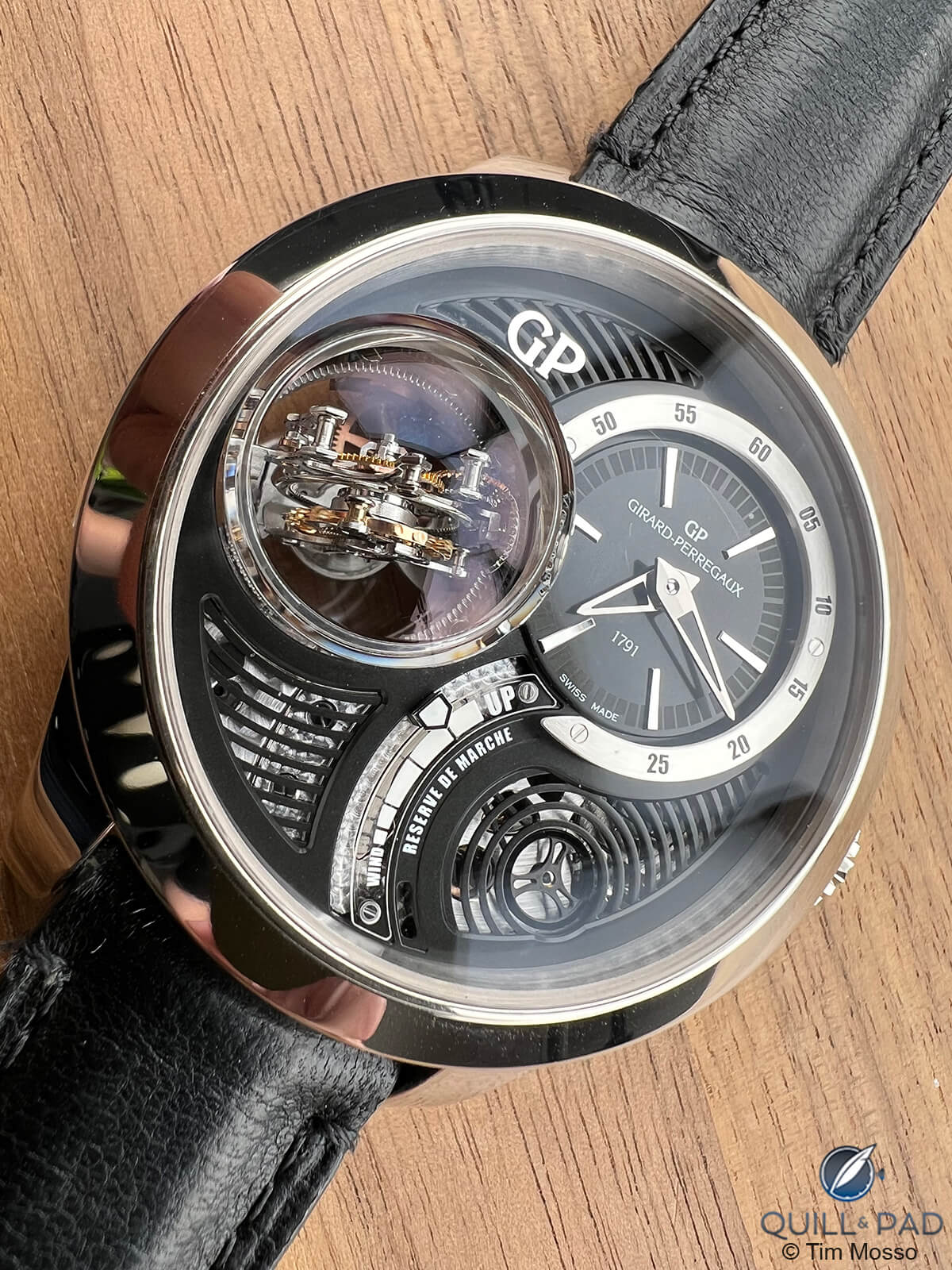
Girard-Perregaux Tri-Axial Tourbillon
Perhaps as a nod to the primacy of its power source, the Tri-Ax’s only luminescent treatment has been applied to the power reserve indicator at the base of the dial.
Detractors of the Rolex “Cyclops Eye” date magnifier might wish to avert their gazes from this dial. The bubble sapphire shroud of the tourbillon offers outstanding visual access to the mechanism, but elevating the tourbillon comes at the expense of a controversial bulge.
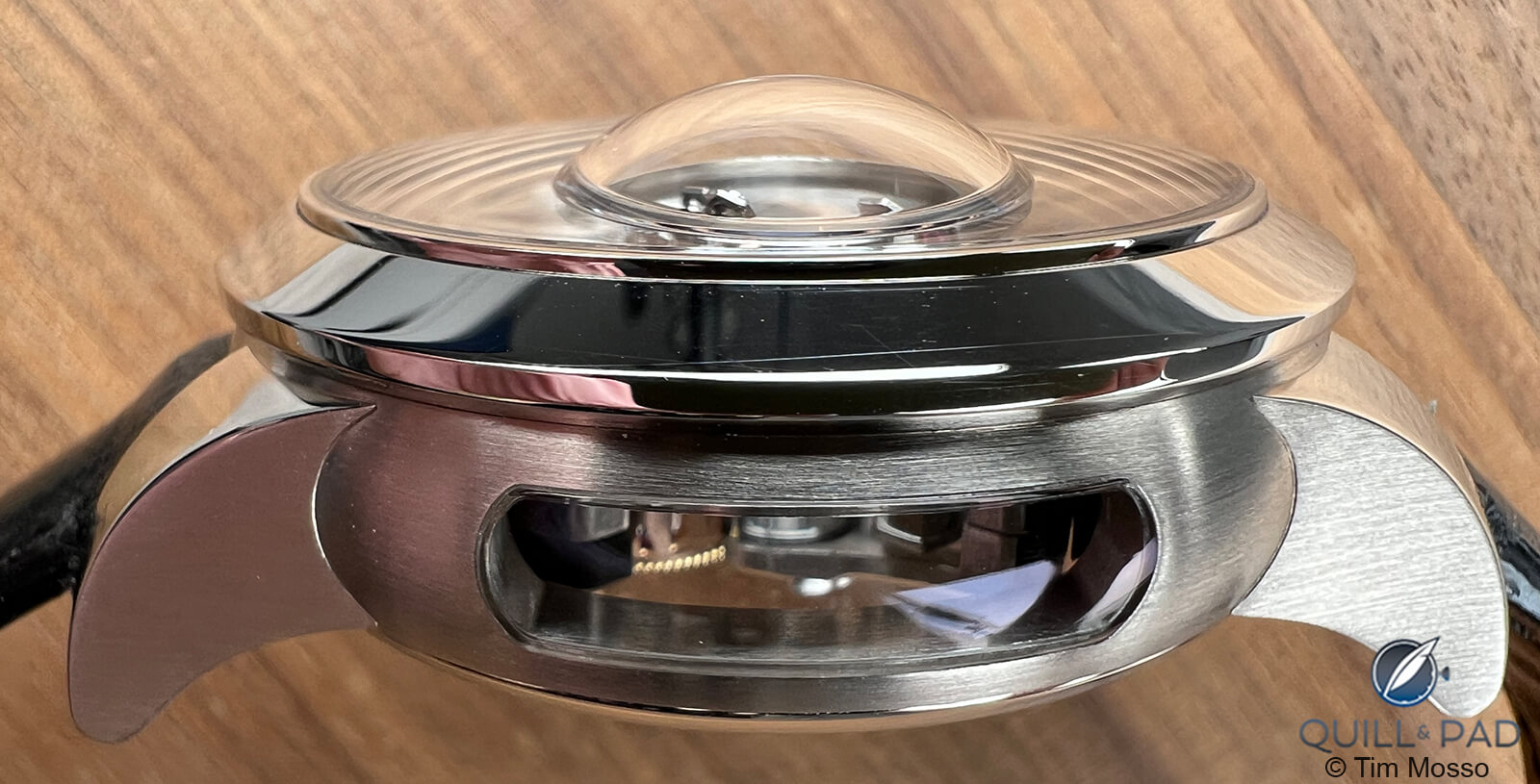
Girard-Perregaux Tri-Axial Tourbillon
However, this is more of an issue for pundits who judge by photographs alone; the drama of the three-axis tourbillon is breathtaking.
Three independent circuits of 120, 60, and 30 seconds whirl in dazzling fashion as the user struggles to process the blur of polished steel, rubies, and Glucydur. It sounds as dramatic as it looks, and a quiet room with this watch crackles with clicks and clacks of a vintage newsroom full of typewriters. It’s a sound that warms the hearts of mechanical watch devotees but places business meetings off-limits to this watch.
More than a carnival of chaos, the tumbling tourbillion is a showcase for Girard-Perregaux’s finest bienfacture. The tourbillon assembly amounts to only 1.24 grams of mass but is comprised of 140 individual components. Aside from the hairspring and jewels, each part of the tourbillon assembly is decorated with eye-watering detail.
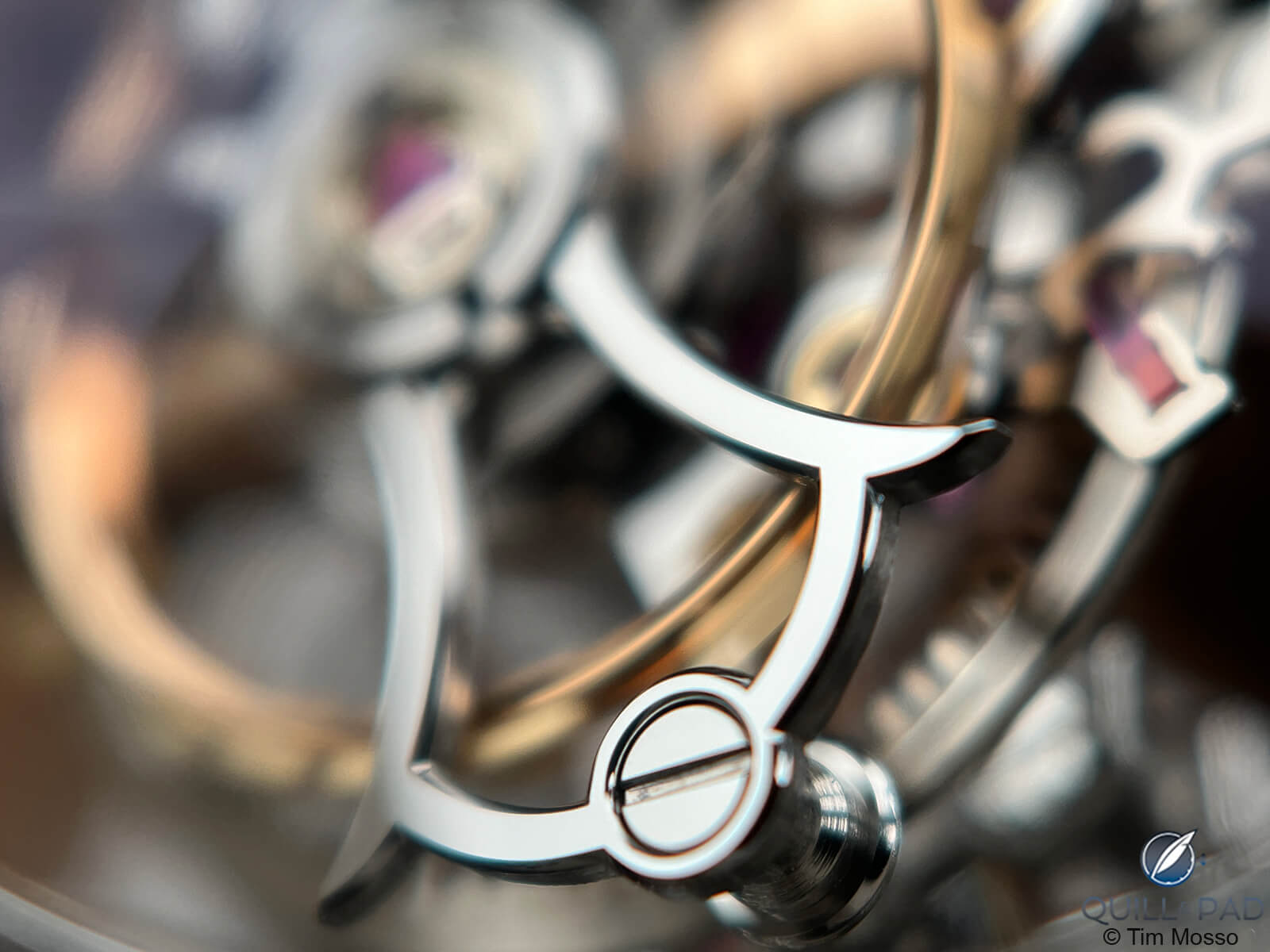
Girard-Perregaux Tri-Axial Tourbillon
Micro-bevels laid with razor-sharp definition, directional brushing of confined surfaces within tiny hollows, and black polish on steel abound.
Bevels converge on interior creases and needle-like exterior points.
While many brands accept lower levels of finishing precision on parts this small – irregular bevels are common on tourbillon cages – the GP is flawless.
Despite viewing ports on the dial, case flank, and caseback of this watch, the only way to fully appreciate this Everest of Girard-Perregaux watchmaking is to observe the tourbillon while static.
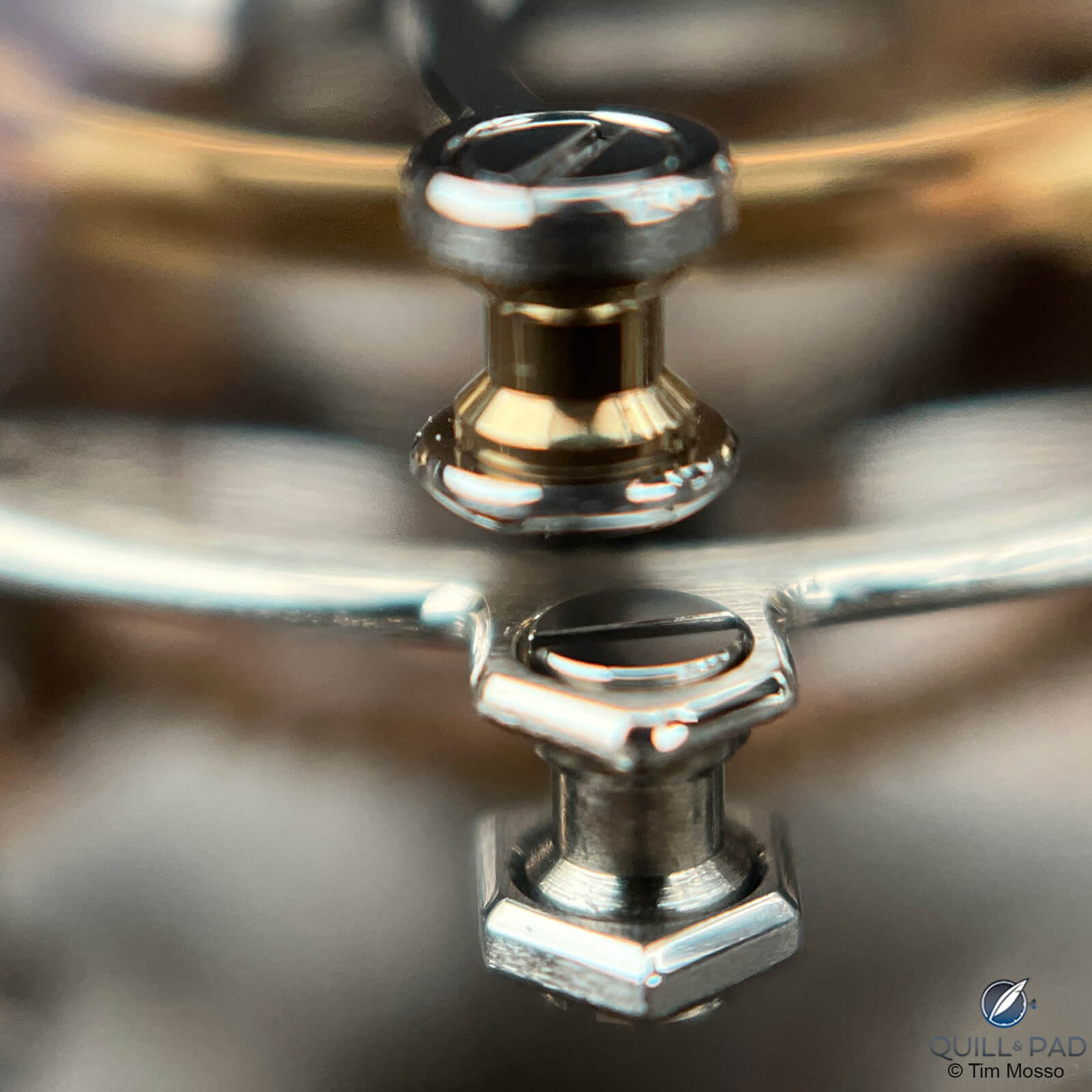
Girard-Perregaux Tri-Axial Tourbillon
Stationary is the only state in which this miniature triumph can be appreciated in full. And bring at least a 10x loupe, because those 140 parts are miniscule.
The dial of the Tri-Ax is the only aspect that feels like a compromise. While the dominant tourbillon bulge monopolizes the left side, a power reserve, hours, minutes, branding, and a pervasive black grille fill out the rest.
Everything but the tourbillon seems to have been placed more as a matter of convenience than artistic vision.
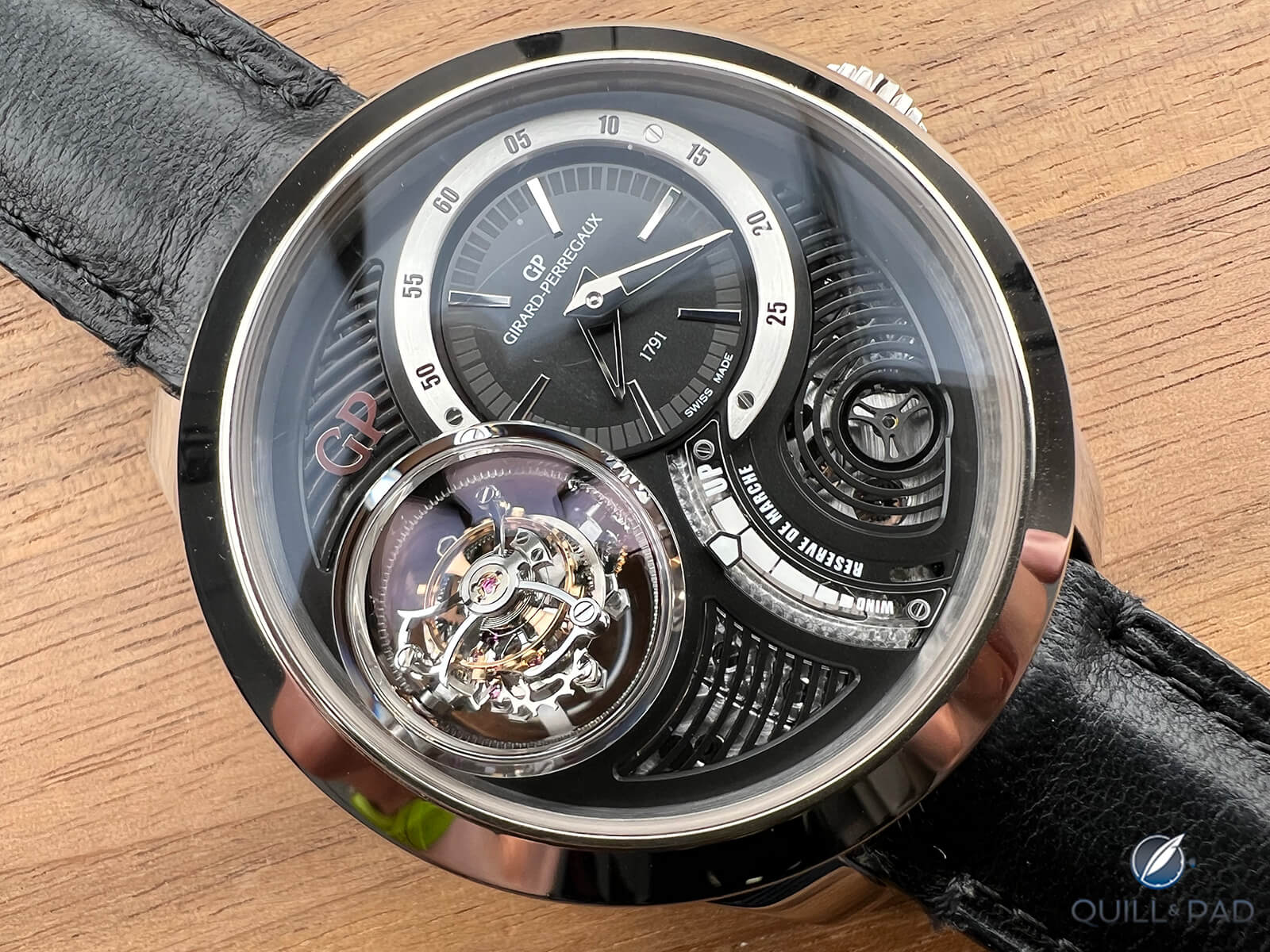
Girard-Perregaux Tri-Axial Tourbillon
Swiss designers’ collective obsession with descriptive text manifests as a 21-character advertisement of the power reserve indicator; the graduated scale alone is sufficient to communicate this information to the user.

Girard-Perregaux Tri-Axial Tourbillon
The black grille gives this Tri-Ax variant (there are several) a sportier look than the light-colored editions. However, narrow slits of the grille are too tightly spaced to permit easy appreciation of the gorgeous movement components beneath it.
Case design is simple but strong. Aside from the movement-determined dimensions, GP designers had the freedom to indulge in high-quality details throughout.
The most prominent element is the sapphire viewing port on the nine o’clock side. With patience, this vantage point reveals certain facets of the tourbillon that are difficult to catch from the reverse or obverse.
The fine finishing is simple: lateral facets are brushed metal, and the upper surfaces including bezel and lug hoods are polished.
Welded-on lugs are an artisanal flourish only possible on low-volume models, and this five-piece series qualifies. Lug welding is a time-consuming way to build a case, but the resulting manual removal of the gathered weld permits razor-sharp breaks between lug and case band – time well spent.
While handsome, the lug span is also prohibitive to small wrists. Lug-to-lug, it measures 58.6mm, and wrists of 18cm circumference or larger are required to ride this whirlwind.

Back of the Girard-Perregaux Tri-Axial Tourbillon
Unlike virtually all modern tourbillon watches, the Tri-Ax surprises with a caseback that hits as hard as its dial. In fact, the reverse of caliber 9300 might be its most impressive facet.

Girard-Perregaux Tri-Axial Tourbillon
Consider the rose gold train wheels that drive the tourbillon; these are the best-finished wheels I’ve ever seen.

Girard-Perregaux Tri-Axial Tourbillon
The interior beveling on the spokes and inner wheel circumferences are unsurpassed by watches I’ve examined from Philippe Dufour, Lang & Heyne, A. Lange & Söhne, and Ferdinand Berthoud. Most Greubel Forsey references fall short. Kari Voutilainen’s Vingt-8 and several watches by Rexhep Rexhepi approach the wheel quality I observed on the GP Tri-Ax. And the even, constant radii of the bevels impress on every surface.
At no point does a bevel spill over to the brushed top of the wheel or exhibit a wobbling irregularity. Moreover, I’ve seen many “Geneva hallmark” watches that lack a single sharp interior angle of converging bevels, but each of these rose gold GP wheels contains 20 – immaculate – inner creases.
In homage to its famed “Tourbillon with Three Golden Bridges,” the reverse of the caliber 9300 includes rose gold drive train bridges shaped in homage to the ancestral three-bridge pocket watch. The same motif can be found on parts of the tourbillon cage, but they’re tough to catch while the device is in motion.

Girard-Perregaux Tri-Axial Tourbillon
Each bridge is anchored by two mirror-like steel screws, and the finish quality on the bridge surfaces matches that of the wheels.
Each of the screws on this opus exhibits spéculaire polish, bevels in their slots, and chamfers around their circumferences. The batwing steel cap anchoring the lower pivot of the tourbillon appears “black” from all angles but a few; it is the famed “poli noir.” All of this must have taken an eternity.

Girard-Perregaux Tri-Axial Tourbillon
Demanding extraordinary money for extraordinary work is a reasonable proposition, but this is the era of buyers who demand ordinary sports watches for extraordinary money. GP’s commercial comeback likely rests on the success of its Laureato sports collection.
Newly independent of its former luxury group and twinned with the better-known Ulysse Nardin, Girard-Perregaux is in rebuilding mode. But recently released editions of the “Esmeralda” tourbillon series indicate the fuoriclasse talents who wrought the Tri-Axial remain at GP’s disposal. The existence of these watches – past and present – provides a rich vein for collectors with an open mind and a budget to match.
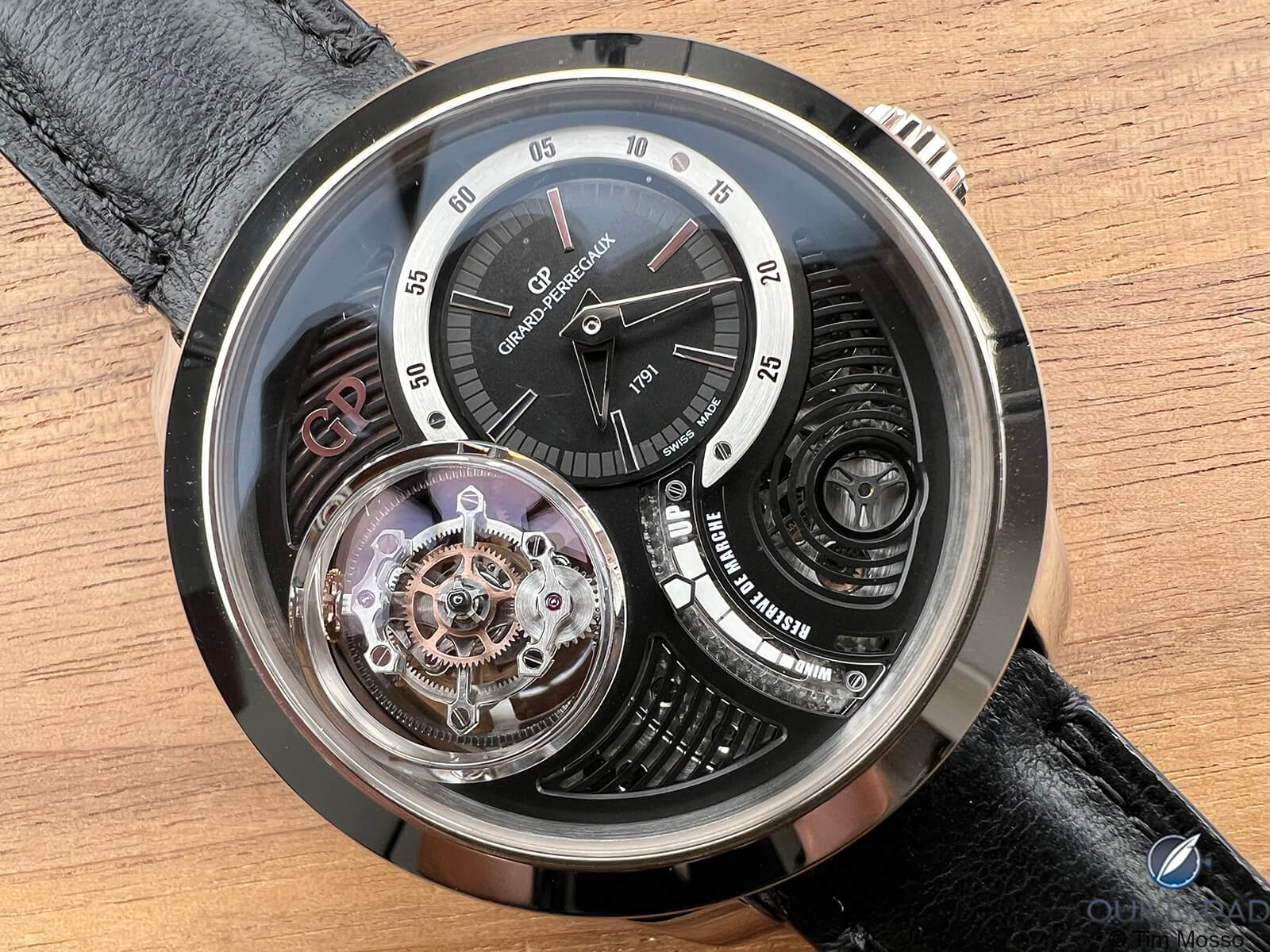
Girard-Perregaux Tri-Axial Tourbillon
For more information on new Girard-Perregaux Tri-Axial Tourbillons, please visit www.girard-perregaux.com/row_en/catalogsearch/result/index/?q=tri-axial
Quick Facts: Girard-Perregaux Tri-Axial Tourbillon
Reference: 99815-53-1612BA6
Case: white gold, 48mm x 18.1mm x 58.6mm
Dial: skeletonized black grill with tri-axial tourbillon and solid time sub-dial
Movement: GP09300-0002, manual wind, 60-hour power reserve, 34 jewels, 3Hz
Functions: triple-axis tourbillon, hours, minutes, power reserve
MSRP 2015: $437,000
Preowned Price 2023: approx. $120,000
* Tim Mosso is the media director and watch specialist at Watchbox. You can check out his very comprehensive YouTube channel at www.youtube.com/@WatchBoxStudios/videos
You might also enjoy:
Girard-Perregaux Laureato: The Underappreciated Royal Oak Substitute?
Girard-Perregaux Goes Full Throttle with Neo Bridges Aston Martin Edition
Girard-Perregaux Neo Constant (Force) Escapement: The Evolution of a Revolution



Leave a Reply
Want to join the discussion?Feel free to contribute!